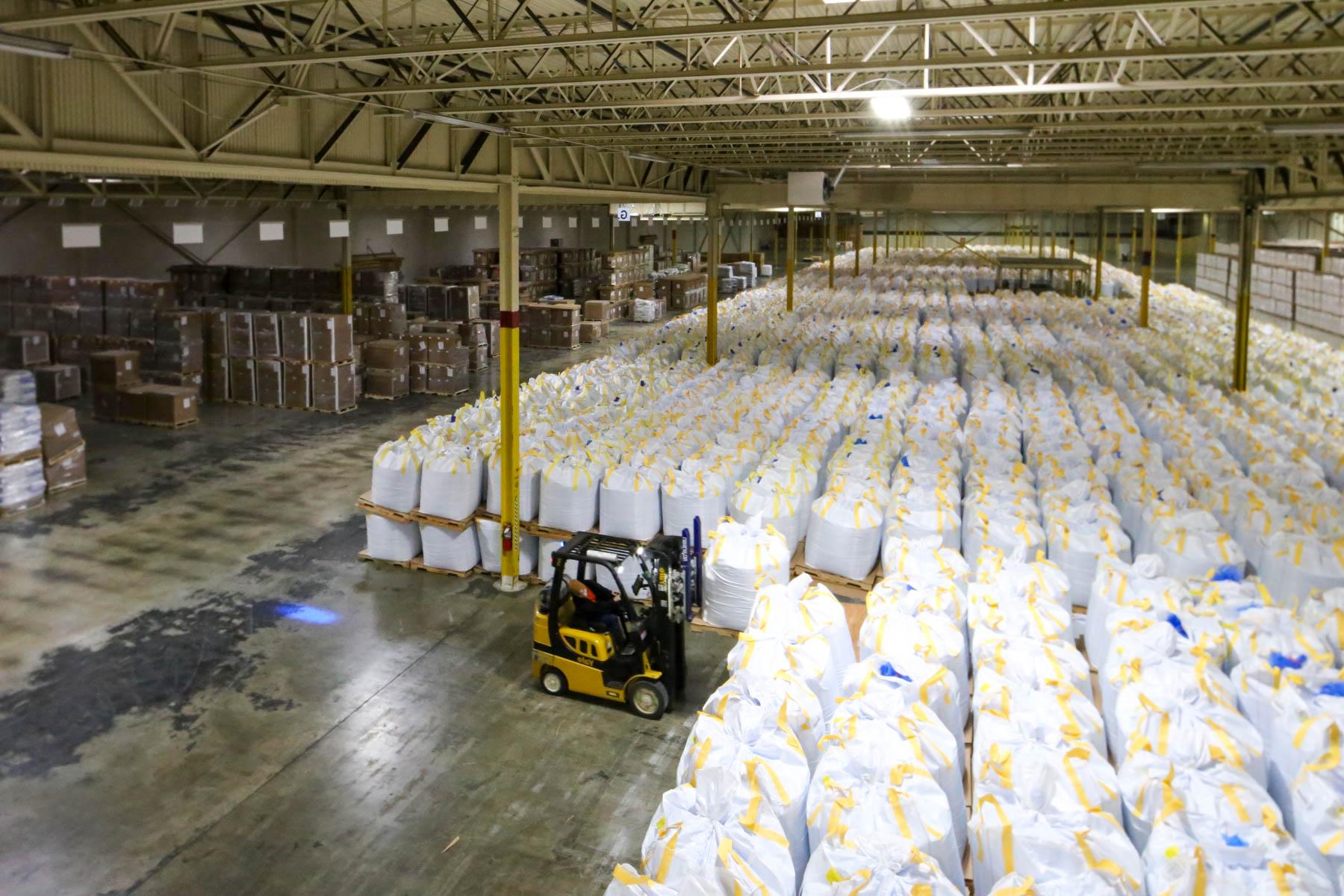
Dry Goods Shipping and Warehousing
Leaders in Food Dry Goods
Shipping and Warehousing
In the logistics supply chain for food products, there is a unique place for the handling of dry goods. This is in large part due to the fact that these types of loads require environmental management. Dry goods, by their very nature, require secure handling so as not to alter their state. If these goods are exposed to moisture, the entire load can be ruined, leading to massive financial loss and delays in the whole supply chain.
What is Dry Goods Shipping?
Dry goods refer to any product that can be stored at room temperature in a dry warehouse environment. These goods can be stored in a variety of warehouse spaces, while their counterparts (Perishables, fresh foods, or cold storage) need specialized facilities and transportation services to keep products at a specific temperature. Dry goods can be consumer goods or food-grade products such as finished shelf-stable food products or food ingredients.
Dry goods manufacturers make up the bulk of the customer base for Murphy Logistics. These goods are an ideal fit for our clean and secure dry goods warehouse, as temperature control is not required. While product safety is a top priority, the flexibility of where and how to store dry goods allows for simpler management in general dry goods shipping and warehousing. Murphy’s teams handle all dry goods from food ingredients to consumer goods, with long-established, top-tier training and proven procedures in place for all dry goods transportation and storage.
How are Dry Goods Stored and Distributed?
One benefit of being a dry goods warehouse is that this type of shipment can easily be stored in a variety of configurations. Dry goods are unique products that can be efficiently stored in many different patterns. From bulk storage options to large packaging, and even stacked in rows or in warehouse racking, the advantage is flexibility when it comes to dry goods shipping and storage.
The most important thing with storing dry goods is ensuring product safety, and not just for the product itself. With everything from stacking heights to maintaining perfect records with expiration dates and practicing inventory control, best practices like First in First Out (FIFO) help dry goods shipping companies ensure your success. This is never more important than when the goods are food or food ingredients.
Food Ingredient Dry Goods Shipping
When it comes to food, products with a built-in time clock and a propensity for spoilage, the most important thing to ensure is product safety. This is most commonly guaranteed by the various certifications that a dry goods warehouse can hold.
Safe Quality Food (SQF) is one of the most comprehensive certifications in the industry for dry goods logistics. Murphy holds this certification in multiple commercial warehousing spaces and has the ability to reduce the chance of shipment waste almost completely. Knowing the manufacturers’ best practices for moving, storing, and distributing products is important for training our warehouse team. With every load we handle, keeping your food chain secure is our top priority!
Dry good distribution all comes down to your own unique requirements. Some products are shipped in full truckload or full pallet quantities, while others are picked and shipped in case/bag pick quantities. Do you need large amounts of product at a specific time for your manufacturing runs? Perhaps instead you need a precise amount of material shipped in small quantities to help maximize space on your floor. Our team of trained warehouse professionals can help you line up any distribution profile for your dry goods.
Dry Goods Transportation
When it comes to the logistics part of dry goods, there is a benefit in that dry goods shipping can be accomplished in a variety of ways. The most common is dry-van transportation, using a 48 or 53-foot trailer. Dry goods can also be moved via rail or even parcel shipments. As long as the products are properly packaged, dry goods are stable at room temperature and can be handled easily by trusted dry goods shipping companies.
Customize Your Dry Goods Shipping
and Warehousing Plan
Murphy Logistics has a fleet of dry vans that routinely haul products on local daily runs, while our OTR logistics team can help line up large-scale dry goods transportation for nationwide shipping, no matter the destination.
Start crafting your custom dry goods shipping plan today. Our team can provide direction, pricing, and strategy. Our dry goods warehouse industry veterans work with companies in a variety of industries regularly, so we have the experience to securely and safely help you with your business needs. Get started by contacting our team today.
Frequently Asked Questions
Dry goods are any products that can be stored at room temperature in a dry warehouse environment. They encompass a broad range of items, including packaged foods like pasta, cereals, and canned goods; non-food items like textiles, paper products, and hardware; and agricultural products like grains, beans, and nuts.
In the food industry, dry goods most commonly refer to non-perishable food items, such as flour, sugar, rice, and dried fruits.
The benefits of using a dry goods warehouse include:
Product safety: Dry goods warehouses are designed to protect products from moisture and other environmental factors that can damage them. This is especially important for food products, which can spoil if they are not stored properly.
Flexibility: Dry goods warehouses can store a variety of products in different configurations. This makes them ideal for businesses that need to store large quantities of products or that need to store products with different expiration dates.
Cost-effective: Dry goods warehouses can be a cost-effective way to store and distribute products. This is because they do not require the same level of investment as cold storage warehouses.
Overall, dry goods warehouses offer a number of benefits that can help businesses keep their products safe and reduce costs.
Dry goods are non-perishable food items that require minimal humidity and climate control. They’re a staple in many kitchens, offering convenience and versatility. Some common types of food-related dry goods include:
Grains and Legumes
Grains: Rice, wheat, barley, oats, corn, quinoa, millet
Legumes: Beans (kidney, pinto, black, etc.), lentils, chickpeas, peas
Pasta and Noodles
Pasta: Spaghetti, macaroni, penne, fettuccine, lasagna noodles
Noodles: Ramen, udon, soba, lo mein
Ingredients
Flours: All-purpose, wheat, bread, cake, pastry
Sugars: Granulated, powdered, brown, demerara
Nuts and Seeds: Almonds, walnuts, pecans, sunflower seeds, chia seeds
Dried Fruits: Raisins, cranberries, apricots, dates, figs
Other Dry Ingredients: Baking powder, baking soda, cornstarch, cocoa powder
Spices and Herbs: Salt, pepper, garlic powder, onion powder, paprika, basil, oregano
Industrial Food Ingredients: malic acid, fumaric acid
Other
Tea
Coffee
Powdered Milk
Some of the considerations for warehouse services providers engaged in shipping dry goods include:
Product safety: Unless properly protected, dry goods can be ruined if exposed to moisture. This is why we choose packaging and procedures that will protect the goods from moisture during transport, such as desiccant packs and humidity control.
Storage: Dry goods can be stored in a variety of configurations, including bulk storage, large packaging, and stacked in rows or in warehouse racking. The type of storage will depend on the specific product and the quantity that needs to be stored.
Transportation: Dry goods can be shipped via dry-van transportation, rail, or parcel shipments. The best mode of transportation will depend on the distance the goods are being shipped, the weight of the shipment, and the cost.
While dry goods are generally easier to handle than perishable items, they still present unique challenges for food grade warehousing companies:
Product Damage: Improper packaging or handling can lead to product damage, such as crushing, tearing, or contamination.
Inventory Control: Maintaining accurate inventory records is crucial, especially for large quantities of various products.
Pests and Contamination: Pests like rodents and insects can infest warehouses and contaminate products. This is why Murphy regularly protects against pest threats with aggressive pest control treatments and processes.
Shelf Life: While dry goods have longer shelf lives than perishable items, they still have expiration dates and can degrade over time, especially if not stored properly.
The regulations for shipping and storing dry goods can vary depending on the specific product and The regulations for shipping and storing dry goods can vary depending on the specific product and the country of origin and destination. However, some common regulations for a dry goods warehouse include:
Food Safety Regulations: For food products, there are strict regulations regarding food safety, labeling, and traceability. Murphy Logistics complies with all regulations as put forth by entities such as the FDA, USDA, FSIS, and more.
Customs Regulations: Importing and exporting dry goods may require customs clearance and adherence to specific customs regulations.
Transportation Regulations: Depending on the mode of transportation, there may be specific regulations regarding packaging, labeling, and hazardous materials when dealing with dry goods shipping.
You can explore all of Murphy’s logistics certifications to see how we adhere to these expectations and regulations.


